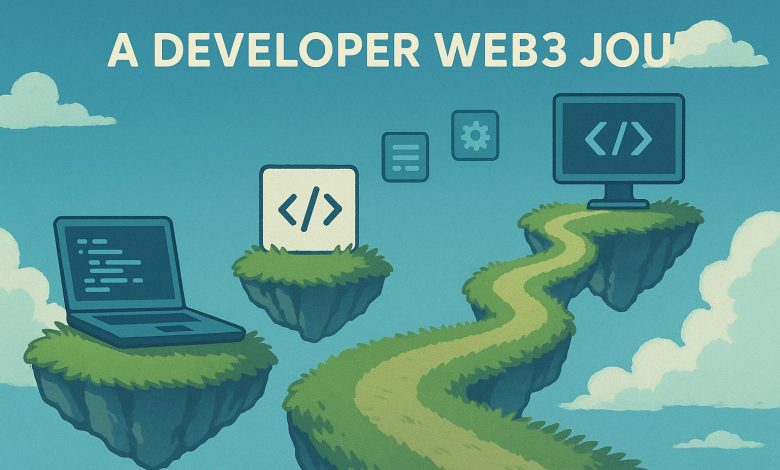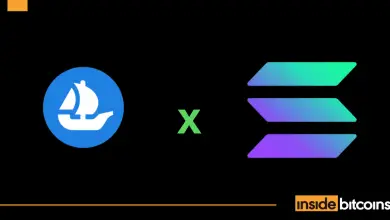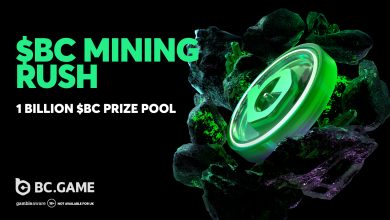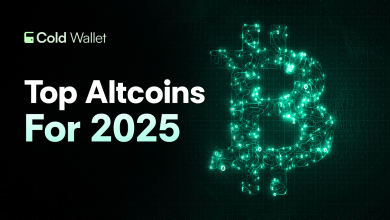Behind the dApp: Understanding Blockchain Architecture

In today’s digital arena, blockchain technology has evolved from an obscure concept behind Bitcoin to a revolutionary approach to data management, trust, and application development. This article will take you on a journey from understanding the fundamentals of blockchain to the practical aspects of building decentralized applications (dApps) and the crucial role that node providers like GetBlock play in the ecosystem.
Understanding the Blockchain
A blockchain is a distributed digital ledger. I like to think of it as a spreadsheet duplicated thousands of times across a network of computers, all updating simultaneously. Unlike traditional databases controlled by a single entity, blockchains distribute control among all network participants.
When someone initiates a transaction on a blockchain network, this information is broadcast to a peer-to-peer network of computers known as nodes. These nodes validate the transaction using established consensus algorithms. Once verified, the transaction joins others to form a “block” which is then added to an immutable chain of previous blocks—hence the term “blockchain.”
Key Insight: The true innovation of blockchain lies in its ability to maintain consensus about the state of data across a distributed network without requiring trust between participants or central authority.
The Immutable Ledger
What makes blockchain special is that once data is recorded in a block and added to the chain, it becomes nearly impossible to change.
Each block contains:
-
A cryptographic hash of the previous block (creating the “chain”)
-
A timestamp
-
Transaction data
-
Other information required by the protocol
This structure creates an inherently tamper-resistant database. If someone attempts to alter a record, they would need to modify not just that specific block, but all subsequent blocks as well—and do so on the majority of computers in the network simultaneously. This is practically impossible, giving blockchain its reputation for immutability and security.
Consensus Mechanisms: How Blockchains Agree
For a decentralized system to function, all participants must agree on the valid state of the ledger. Different blockchains use different methods to achieve this consensus.
Proof of Work (PoW)
Bitcoin pioneered the Proof of Work consensus mechanism. In this system:
-
Miners compete to solve complex cryptographic puzzles
-
The first to solve the puzzle gets to add the next block to the chain
-
This process requires significant computational power and energy
-
The difficulty of the puzzles adjusts automatically to maintain consistent block times
This mechanism is secure but energy-intensive, leading to environmental concerns and scalability challenges.
Proof of Stake (PoS)
As an alternative, Proof of Stake selects validators based on the amount of cryptocurrency they’re willing to “stake” or lock up as collateral:
-
Validators are chosen to create blocks based partly on how much of the network’s cryptocurrency they have staked
-
Creating invalid blocks results in losing some or all of their staked assets
-
This approach drastically reduces energy consumption compared to PoW
-
Ethereum completed its transition from PoW to PoS in 2022, in an event known as “The Merge.”
Other consensus mechanisms exist, including Delegated Proof of Stake (DPoS), Proof of Authority (PoA), and hybrid approaches—each with unique trade-offs in terms of decentralization, security, and efficiency.
The Network Infrastructure: Understanding Blockchain Nodes
Nodes are the backbone of any blockchain network. Think of nodes as the individual computers that store copies of the blockchain and enforce its rules. They connect to share information and maintain the network’s integrity.
The Node Hierarchy
Not all nodes are created equal. Most blockchain networks have several types of nodes with different responsibilities:
Light Nodes
Light nodes (also called “light clients” or “SPV nodes”) are the most accessible entry point to blockchain networks:
-
They download only block headers, not the entire blockchain
-
They verify transactions using simplified payment verification (SPV)
-
They rely on full nodes for detailed information
-
They can run on devices with limited resources, like smartphones
-
For Ethereum, light nodes typically require only about 1GB of storage space
Light nodes allow users to interact with the blockchain without the resource commitment of running a full node.
Full Nodes
Full nodes form the core of the blockchain network:
-
They download and validate every block and transaction
-
They enforce all the rules of the blockchain protocol
-
They independently verify all information without trusting other nodes
-
They require significant storage capacity
-
They typically need a dedicated machine with reliable internet connection
Recommended hardware requirements for Ethereum Full node:
- Fast CPU with 4+ cores. High Ghz/Core is important, starting at 3.5 Ghz and more
- 16 GB RAM minimum requirement, 32GB is recommended
- SSD drive with a 2TB disk space. As the amount of data capacity varies, a 4TB SSD drive is recommended to avoid disk space upgrades in the future.
Full nodes contribute to network security and decentralization by independently verifying that all transactions follow the network’s rules.
Archive Nodes
Archive nodes store the complete history of the blockchain:
-
They maintain historical states of the blockchain at every block
-
They allow querying the state of any account at any point in time
-
They require massive storage capacity (Ethereum’s archive nodes currently exceed 12TB)
-
They are primarily used by researchers, data analysts, and infrastructure providers
Running an archive node requires significant technical expertise and hardware investment, making them rare compared to other node types.
A default full node keeps the most recent 128 block’s state data while an archive node keeps all historical state data.
Public vs. Self-Hosted Nodes
When interacting with a blockchain, developers have two primary options:
-
Public Nodes are maintained by third parties and accessible to anyone. They’re convenient but may have limitations in terms of reliability, rate limits, and privacy.
-
Self-Hosted Nodes are operated by the developer or organization. They offer complete control but require significant technical resources:
- Server infrastructure (physical or cloud-based)
- Ongoing maintenance and updates
- Security monitoring
- High bandwidth and storage capacity
- Technical expertise to troubleshoot issues
For most developers, especially those just starting with blockchain development, the overhead of running self-hosted nodes outweighs the benefits.
Decentralized Applications (dApps)
What Makes an Application “Decentralized”?
Traditional applications typically run on servers controlled by a single entity. In contrast, decentralized applications (dApps) operate on blockchain networks, distributing both their backend code and data across multiple nodes.
A true dApp has several distinguishing characteristics:
-
Open-source code: The application’s source code is available for anyone to inspect and verify
-
Autonomous operation: Once deployed, the application runs without central control
-
Decentralized data storage: Application data is stored on the blockchain or decentralized storage systems
-
Cryptographic tokens: Many dApps use tokens to incentivize participation and governance
This architecture provides several advantages over traditional applications, including censorship resistance, transparency, and user ownership of data.
The Technical Architecture of dApps
A typical dApp consists of several layers:
-
Smart contracts: Self-executing code deployed on the blockchain
-
Frontend interface: The user-facing application that interacts with smart contracts
-
Web3 libraries: Software that facilitates communication between the frontend and blockchain
-
Node connection: The gateway that allows the dApp to read from and write to the blockchain
This last component—the node connection—is where many developers encounter challenges. Your dApp needs a reliable way to communicate with the blockchain network, which is where node providers become essential.
Choosing Your Blockchain
The first major decision in dApp development is selecting which blockchain to build on. Some popular options include:
-
Ethereum: The pioneer of smart contracts with the largest developer ecosystem
-
Solana: Known for high throughput and low transaction costs
-
Base: An Ethereum layer-2 solution offering faster and cheaper transactions
-
BNB Smart Chain: A blockchain focused on decentralized finance applications
-
Avalanche: Emphasizing high throughput and quick finality
Each platform has its own strengths, limitations, and developer tools. Your choice should align with your application’s requirements for speed, cost, security, and developer support.
Essential Programming Languages and Tools
Building dApps requires familiarity with several technologies:
Smart Contract Languages:
-
Solidity (Ethereum, Base and other EVM-compatible chains)
-
Rust (Solana, Near, Polkadot)
-
Vyper (Alternative for Ethereum)
Development Frameworks:
-
Truffle Suite: Development environment, testing framework, and asset pipeline
-
Hardhat: Ethereum development environment designed for professionals
-
Foundry: Fast, portable toolkit for Ethereum application development
Smart Contract Libraries:
-
OpenZeppelin: Secure, tested templates for common smart contract functions
-
Chainlink: Oracles for connecting smart contracts to real-world data
Frontend Libraries:
-
ethers.js, web3.js: JavaScript libraries for interacting with Ethereum
-
React.js: Popular frontend framework for building user interfaces
-
Next.js: React framework with server-side rendering capabilities
Testing Tools:
-
Ganache: Personal blockchain for Ethereum development
-
Mocha/Chai: JavaScript testing frameworks
-
Waffle: Library for writing and testing smart contracts
Node Access:
The Critical Role of Nodes in dApp Development
When building a dApp, you need consistent access to blockchain data. Your application must:
-
Read current state from the blockchain
-
Send transactions to the network
-
Monitor events and updates
-
Access historical data when needed
All these functions require a connection to at least one blockchain node. As your application grows, you’ll need reliable, scalable access to nodes—often across multiple blockchains.
The Node Provider Solution: How GetBlock Bridges the Gap
The Evolution of Blockchain Infrastructure
In the early days of blockchain development, running your own nodes was practically a requirement. This created a significant barrier to entry for developers without extensive resources.
Node providers emerged as a solution to this problem, offering reliable blockchain access without the overhead of self-hosted infrastructure. They maintain high-availability node clusters and provide simple API endpoints for developers.
How Node Providers Work
A node provider like GetBlock performs several essential functions:
-
Maintains infrastructure: Operating dozens or hundreds of nodes across multiple blockchains
-
Ensures high availability: Implementing redundancy and load balancing
-
Handles upgrades: Keeping nodes updated with the latest protocol versions
-
Provides simple access: Offering standardized API endpoints for developers
-
Scales resources: Adjusting capacity based on demand
This service model transforms blockchain development from an infrastructure challenge into a straightforward API integration.
GetBlock: A Comprehensive Node Provider Solution
GetBlock exemplifies the modern node provider approach. It offers access to over 50 blockchain protocols through a unified interface. Their service includes:
-
Multiple access methods: JSON-RPC, REST, WebSocket, and GraphQL APIs
-
Flexible deployment options: Shared nodes for testing and development, dedicated nodes for production applications
-
Node clusters: Enterprise-grade infrastructure with load balancing and failover protection
-
Cross-chain compatibility: Access to Bitcoin, Ethereum, Solana, Polygon, BNB Smart Chain, and many more from a single provider
-
Developer-friendly resources: Comprehensive documentation and 24/7 support
For developers, this means focusing on application logic rather than infrastructure management, allowing you to accelerate development cycles and reduce operational overhead.
Integrating with a Node Provider
Connecting your dApp to a node provider like GetBlock typically involves a few straightforward steps:
-
Sign up for an account: Create an account and select a subscription plan
-
Generate API keys: Obtain authentication credentials for the blockchains you need
-
Configure your dApp: Update your Web3 provider configuration to use the provider’s endpoints
-
Test connections: Verify that your application can read from and write to the blockchain
Most Web3 libraries make this integration seamless. For example, with ethers.js, connecting to Ethereum through GetBlock is as simple as:
// Import the Ethers library
const { ethers } = require('ethers');
// Set up the provider (replace ACCESS_TOKEN with your actual token)
const provider = new ethers.JsonRpcProvider('
//Call a method using the provider
const main = async () => {
const blockNumber = await provider.getBlockNumber();
console.log("Latest Block Number:", blockNumber);
};
// Call the main function
main();
The Future of Web3 Development
As blockchain technology continues to mature, we’re seeing several emerging trends:
-
Cross-chain applications: dApps that operate across multiple blockchains
-
Layer-2 scaling solutions: Technologies that improve throughput and reduce costs
-
Privacy-preserving techniques: Methods to balance transparency with confidentiality
-
Improved developer experience: More intuitive tools and frameworks
-
Enterprise adoption: Integration of blockchain into traditional business processes
Node providers will play an increasingly important role in this ecosystem, abstracting away infrastructure complexity and allowing developers to focus on innovation.
Conclusion: Lowering the Barrier to Web3 Development
Blockchain technology offers a new paradigm for building applications—one based on transparency, user ownership, and trustless interactions. However, the technical complexity of blockchain infrastructure has historically been a barrier to entry.
Node providers like GetBlock are changing this dynamic, making blockchain development accessible to a broader range of developers. By offering reliable, scalable access to blockchain networks, they enable developers to focus on what matters most: building innovative applications that leverage the unique capabilities of blockchain technology.
Whether you’re a seasoned blockchain developer or just beginning your Web3 journey, understanding the role of nodes and node providers is essential to building successful decentralized applications. As the technology continues to evolve, these infrastructure services will remain a critical enabler of blockchain innovation.
Hope you found this helpful.






